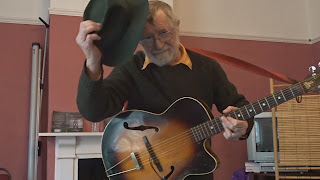Sabbie Dare and Friends
The Soundtrack of a Novel
“All art constantly aspires towards the condition of music”
Walter Pater’s said that. It’s a famous quote of his, more famous than he is. When I first heard it, I checked him out, to find he was a nineteenth-century art critic and literary theorist who was born in the East End of London.
Some think that this quote is bunkum, and that art doesn’t move towards being music, but the idea resonates with me. Why else would Leonard Cohen have moved his writing sideways from prose and poetry to lyrics (oh! the money, maybe…). Music often enhances reading; I played Bob Marley all the time when I was consumed by A Brief History of Seven Killings
When I write, I’m always aware that certain scenes make a sort of music in my head. My characters, right from before I had anything published, always listened to music, often (this is possibly why these stories weren't published!) for long, closely-described scenes.
Then I read the critically acclaimed Teddy Wayne, and heard about how he created a ‘soundtrack’ to his most recent novel Loner, an unsettling story of obsessive desire. In his article, Wayne says…A great deal of pop songs are also about romantic obsession and loneliness (often in the same breath), and many ostensible love songs, when you examine the lyrics, are really avowals of stalker-like pursuit or thoughts of the object of desire; the British seem to have a particular fondness for this kind of ballad.
Wayne chose ten tracks that informed his portrayal of his protagonist. I’m writing book four of the Shaman Mysteries, Flood Gate, and I'm doing the same thing. My chosen tracks each represent a character, and I’m finding wonderful inspiration from listening to these songs. Follow the links to hear the music.
In order of appearance:
Larry Waish is a small-time poultry farmer who recently lost all his hens in one of the many floods that plague the Somerset Levels. What he’s discovered, is that his neighbour is to blame for his loss, and he’s hopping mad. Larry really loves Country and Western and plays The Eagles Heartache Tonight a lot, while he’s trying to cope with what happened between him and Jack Spicer at Harper’s Coombe
Jack Spicer, who’s real name is John, farms 200 acres of Somerset land, as his family has for generations. He's recently lost his daughter, and is helping bring up her daughter, baby Olivia. He knows he's been driven to do wrong, and t’s tormenting him. He's a bit of a classical buff, and listening to the slightly sinister tones of Shostakovich’s first piano concerto helped me build his character. By the end of chapter one, Jack is dead.
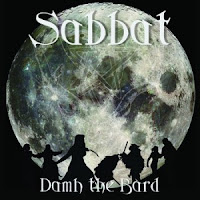 Sabbie Dare is a young shamanic practitioner and therapist who knows it is her destiny to be of service to people on the very edge of life. The victims of evil…the perpetrators of it. Sabbie’s mad about Pet Shop Boys and pagan music which can vary from folksy to rocking, and includes groups like Incubus Sucubus, Dahm the Bard and The Dolmen
Sabbie Dare is a young shamanic practitioner and therapist who knows it is her destiny to be of service to people on the very edge of life. The victims of evil…the perpetrators of it. Sabbie’s mad about Pet Shop Boys and pagan music which can vary from folksy to rocking, and includes groups like Incubus Sucubus, Dahm the Bard and The Dolmen
Kelly King was 28 when she threw herself off the Clifton Suspension Bridge. She’d never really recovered from her life in The Willows, a local authority children’s home where Kelly, Sabbie and Debs Hitchings all lived when they were children. Kelly was depressed, directionless, and addicted to chocolate cookies. In her last days, she plugged into the music of her childhood, such as Pink’s There you go.
Debs Hitchings is a beautician who wanders from boyfriend to boyfriend and job to job. Debs turned up at the very end of In the Moors, (Book One) where she cuts Sabbie’s tortured hair, and has a small part in Unraveled Visions. In this book Debs, and the story of her past, takes centre stage. She’s known for cracking out Beyoncés Crazy in Love
at the top of her voice as her heels skittered across nighttime pavements.
|
https://www.milesdavis.com |
Quentin Lachapelle is a thirty-five year old photographer with a nice studio, a pretty wife, and a flourishing career. He meets Sabbie and Debs at Kelly King's funeral, where he offers to take some glamour shots of Debs, although he finds Sabbie’s dark skin tones and angled face interesting. There is more to Quentin that meets the eye…or the lens of his cameras. Quentin is a Miles Davis fan, of course.
DI Reynard Buckely. Fans of the Shaman Mysteries will be delighted to hear that and Rey and Sabbie are still an item. In fact, things hot up between them considerably! Rey made his musical preferences clear in In the Moors, so there’s only one group I could play, and that’s the Stones.
Fenella Waish is Larry’s sister. Now in her forties, but still living in their childhood home, Fen seeks help from Sabbie for longterm Ornithophobia, her paralysing fear of birds which prevents her going anywhere near Larry’s poultry shed. Fenella loves her laptop, which is her window on the world. Scared to be Lonely might bring tears to her eyes, but she plays it again and again.
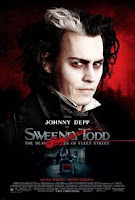 Tara Yorkman. Before she died, Kelly was fruitlessly searching for her friend Tara, who lived at The Willows from when she was little. Kelly, in need of someone to care for, always looked out for Tara, until she was a teenager. Then she disappeared. When Kelly’s spirit comes to Sabbie in a dream, she feels indebted to continue the quest for the missing girl. I listen to Taylor Swift and other noughties music to get in touch with Tara.
Tara Yorkman. Before she died, Kelly was fruitlessly searching for her friend Tara, who lived at The Willows from when she was little. Kelly, in need of someone to care for, always looked out for Tara, until she was a teenager. Then she disappeared. When Kelly’s spirit comes to Sabbie in a dream, she feels indebted to continue the quest for the missing girl. I listen to Taylor Swift and other noughties music to get in touch with Tara.
Victor Doyle is a successful Bristol business man, a builder of local housing. Now 55, he's loaded, charming and still handsome in a chiselled way, although he’s put on a bit of weight. In the community, he’s a well-loved philanthropist, but underneath, the man is pure, unadulterated evil. I think he’d be rivitted by Pretty Women from Sweeny Todd.
If you're writing a novel, or a series of short stories, try finding and playing the soundtrack that perfectly accompanies the story and the characters. It can make a tremendous difference to the outcome.
 2
2
Books Are the Things That Make Us

Books are the Thing that Makes Us
 I can’t pretend I didn’t grow up on Enid Blyton, but the works that made the most impression were the magical Narnia stories, the weird adventures of Alice and the tiny world of The Borrowers. By the time I was twelve, I’d read all of the Anne of Green Gables series. I loved the way Anne hurtled through life. Her ‘modular’ way of learning (by making every mistake in the book – literally) suits me to this day. But, as the books watched her grow into a woman, I also (creep!) loved her commitment to duty and her attitude to life, which reminds me of that quote from Man for all Seasons, when Richard Rich asks… 'If I was, (a teacher) who would know it?' And Thomas Moore replies…'You, your pupils, your friends, God. Not a bad public, that…’
I can’t pretend I didn’t grow up on Enid Blyton, but the works that made the most impression were the magical Narnia stories, the weird adventures of Alice and the tiny world of The Borrowers. By the time I was twelve, I’d read all of the Anne of Green Gables series. I loved the way Anne hurtled through life. Her ‘modular’ way of learning (by making every mistake in the book – literally) suits me to this day. But, as the books watched her grow into a woman, I also (creep!) loved her commitment to duty and her attitude to life, which reminds me of that quote from Man for all Seasons, when Richard Rich asks… 'If I was, (a teacher) who would know it?' And Thomas Moore replies…'You, your pupils, your friends, God. Not a bad public, that…’In some ways, the books I read made me the person I am. They were probably more influential than my textbooks or my teachers…or even my parents.
Queue Here for the Best New Novels for 2017!
 I’ll let you into a little secret. I’ve just sent a complete draft of the next Shaman Mystery to my agent…and she loved it. So now I’m polishing it up with a rag, some spittle and a tin of beeswax, in the hope that, sometime in 2017, FLOOD GATE, will start to become a book.
I’ll let you into a little secret. I’ve just sent a complete draft of the next Shaman Mystery to my agent…and she loved it. So now I’m polishing it up with a rag, some spittle and a tin of beeswax, in the hope that, sometime in 2017, FLOOD GATE, will start to become a book.
In the meantime, I wanted to know which great writers already have a book in the new year pipeline, and can reveal that the news is exciting.
I did enjoy The Girl on the Train, even though I knew there were flaws in the plot, because I firmly believed in the main character and her descent into alcohol hell. Paula Hawkins’ new book Into the Water, is out in 2017, and I wish her all success with it. She’s sticking to the psychological thriller genre, using, I hear, themes of truth and family secrets. Definitely one to try.
 It always puzzles me, why some first-time authors with huge success, don’t write a second book, while some churn out one every year. I loved Arundhati Roy’s Booker winner, The God of Small Things when I read it in 1997, and now, 20 years after its publication, her 2nd book, The Ministry of Utmostherppiness (Hamish Hamilton) is due out. The one thing I now know, is that she’s still good at titles! I do hope it’s worth the long wait.
It always puzzles me, why some first-time authors with huge success, don’t write a second book, while some churn out one every year. I loved Arundhati Roy’s Booker winner, The God of Small Things when I read it in 1997, and now, 20 years after its publication, her 2nd book, The Ministry of Utmostherppiness (Hamish Hamilton) is due out. The one thing I now know, is that she’s still good at titles! I do hope it’s worth the long wait.
 Colm Toibin only came to my attention when someone recommended Testament of Mary. I was impressed with his take on a New Testament character, and also with his ability to get deeply into the female mind. In May 2017, he’s releasing House of Names, telling the story of how Agamemnon orders the sacrifice of his daughter, to gain good omens for the Trojan war. When he sails home victorious at last, he’s faced with a family filled with hate and the need for vengance. The last book I read about the Illiad was THE SONG OF ACHILLES by Madeline Miller, which won the 2012 Orange Prize. I loved that book, and I hope that this one proves as exciting.
Colm Toibin only came to my attention when someone recommended Testament of Mary. I was impressed with his take on a New Testament character, and also with his ability to get deeply into the female mind. In May 2017, he’s releasing House of Names, telling the story of how Agamemnon orders the sacrifice of his daughter, to gain good omens for the Trojan war. When he sails home victorious at last, he’s faced with a family filled with hate and the need for vengance. The last book I read about the Illiad was THE SONG OF ACHILLES by Madeline Miller, which won the 2012 Orange Prize. I loved that book, and I hope that this one proves as exciting.
One of my favourite writers, Neil Gaiman, has also chosen to weave mythology and legend into modern storytelling in his latest offering, Norse Mythology, due out in February. Gaiman’s ability with words, and his subtle understanding of how to use symbol and allegory, will surely promise this to be a great read.
Right this moment I’m reading Michael Chabon’s Maps and Legends, a book of essays about reading and writing, but he’s most famous for Wonder Boys, one of my favourite books and also a great movie staring Michael Douglas as a washed-up author who discovers the next wunderkind
in his creative writing class. I’ve always had a theory about Wonder Boys; surely it started life as one of those writing exercises where you take various crazy items and have to work them into a story – in this case – Marilyn Monroe’s jacket, a dead dog, a tuba-paying transvestite and a squashed boa constrictor. Will Moonglow, (Fourth Estate) be as inventive and funny as Wonder Boys? I sincerely hope so.
Later in the year, lovers of William Boyd will have a treat with The Dreams of Bethany Mellmoth. Last summer, I read his story of an early female photographer, Sweet Caress, and I’m ready for more.
I’m ‘into’ The Hogarth Shakespeare Project at the moment, which is asking bestselling novelists to retell Shakespeare's works. "Hogarth" was launched in October last year, with Jeanette Winterson's take on The Winter’s Tale. I’ve just finished Margaret
Atwood’s Hag-Seed and loved it – laughed all the way through, while marvelling at her brilliantly woven analysis of The Tempest. Read a full review of the book here. Since reading it, I’ve watched Helen Mirren as Prospera in the DVD of Julie Taymor’s version of The Tempest, and have booked up to see the Royal Shakespeare version which is on now in Stratford on Avon.
next book in the project’s series, written by Tracy Chevalier, famous for Girl with a Pearl Earring. She has rewritten Othello. In New Boy, the story of Othello is set in a Washington school, with 11-year-old friends Osei, Dee, Ian and Mimi being the key players in the tragedy.
 And finally, I’m looking forward to Tessa Hadley's next book of short stories. She was my tutor on my creative writing master’s degree, and I’ve admired her work every since. Brilliantly observant of the human condition, and a lyrical writer, she’s particularly great at the tricky form of short fiction. In Bad Dreams, the stories focus in on crucial moments of transition, and the blurb is enticing me to put my pre-order in…real things that happen to people, the accidents that befall them, are every bit as mysterious as their longings and their dreams.
And finally, I’m looking forward to Tessa Hadley's next book of short stories. She was my tutor on my creative writing master’s degree, and I’ve admired her work every since. Brilliantly observant of the human condition, and a lyrical writer, she’s particularly great at the tricky form of short fiction. In Bad Dreams, the stories focus in on crucial moments of transition, and the blurb is enticing me to put my pre-order in…real things that happen to people, the accidents that befall them, are every bit as mysterious as their longings and their dreams.
In the meantime, while we’re still waiting for these books to arrive from Amazon, or at our chosen bookshops, I’ll wish you a very happy, prosperous and healthy 2017, and get back to putting the finishing touches to my latest novel, in which I delve into some shocking secrets that Sabbie Dare discovers in her past…
 1
1
The UK Costa Book Awards
Costa Book Awards – the shortlists are out!
 Another year, another book prize announced. This is one of my favourite book prizes, which has afforded me unbelievable reading. Novels like The Shock of the Fall by Nathan Filer, Elizabeth is Missing by Emma Healey, How to be Both by Ali Smith, Bring up the Bodies by Hilary Mantel.
Another year, another book prize announced. This is one of my favourite book prizes, which has afforded me unbelievable reading. Novels like The Shock of the Fall by Nathan Filer, Elizabeth is Missing by Emma Healey, How to be Both by Ali Smith, Bring up the Bodies by Hilary Mantel. Costa offers several awards each year, Novel Award, First Novel, Biography, Poetry, Children’s Book, and Short Story, and I already have several of the shortlist for each of these on my own ‘to read list’.
 I’m keen to get Rose Tremain’s The Gustav Sonata. I’ve love Tremain since she began to write, which is many moons. She has won the Orange Prize, the Whitbread Award, the Sunday Express Book of the Year and been short-listed for the Booker Prize. But when I recently read her book Trespass I was thrilled to find she’d written a novel about murder. Was Tremain writing a crime thriller? My review of Trespass can be found here This new novel is set in Switzerland where the second world war is still a long-ago echo coming off the mountains. It’s described as “a striking portrait of friendship”
I’m keen to get Rose Tremain’s The Gustav Sonata. I’ve love Tremain since she began to write, which is many moons. She has won the Orange Prize, the Whitbread Award, the Sunday Express Book of the Year and been short-listed for the Booker Prize. But when I recently read her book Trespass I was thrilled to find she’d written a novel about murder. Was Tremain writing a crime thriller? My review of Trespass can be found here This new novel is set in Switzerland where the second world war is still a long-ago echo coming off the mountains. It’s described as “a striking portrait of friendship” It felt a very pertinent and current read at the time, and is partly his memories of his childhood, during the time Colonel Gaddafi's regime took hold in the seventies. A boy of nine watches his father taken away for questioning and does not know what to think, or whom to trust. The novel is writing in such deceptively simple prose, but powerfully examines themes of conflict, family ties, and betrayal.
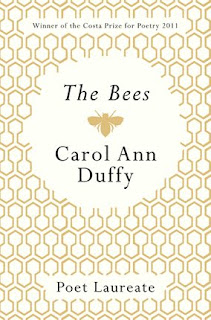 |
| http://www.picador.com/books/the-bees |
 1
1
Gold-Starred Rules for Shy Networking Writers
Gold-Starred Rules for Shy Networking Writers
 |
| Nina Milton, speaking and reading at the Wells Literary Festival |
 |
| Click to see more |
 |
| Me at the Carmarthen Book Fair |
- SMILE,
- ASK A QUESTION,
- LISTEN,
- LEARN THE NAMES.
 1
1
Seamlessly Blends the Mystical…A review of Beneath the Tor by Nina Milton
Seamlessly Blends the Mystical…
Thank you, Indie Shaman for you marvellous review of the third in the Shaman Mystery Series.
Beneath the Tor is a compelling and well-paced mystery which contains recognisable and authentic diverse characters…an absorbing and intriguing murder mystery.
I was so delighted when June Kent, editor of the Indie Shaman Magazine review my latest novel, because I love that magazine! Every issue is packed with articles on spirituality and shamanism, laid out in a colourful and well-balanced way, with regulars, such as Plant lore, a poem, Community News and always contributions from the elders of the shaman world. Book reviews are a regular in the mag, and I was proud – honoured – to be among them.
Almost as important, I can buy Indie Shaman as a hold-in-the-hand magazine. I spend enough time on that computer – I like to flop down in comfort to read…especially when the mag says lovely things about my writing…
Set in the West Country, Beneath the Tor is the 3rd of author Nina Milton's Shaman Mystery series in which therapeutic shaman Sabbie Dare uses her shamanic skills to solve murder mysteries.
I write my crime thrillers for all readers, but as Sabbie Dare, my central character in the series, is a shamanic practitioner by trade, the opinion of those who live a shamanic way of life is crucial to me. I aim to make my books, and my heroine, authentic, and so I was quite relieved when the review reinforced this, saying how the book…features many of the issues that affect contemporary shamanism including the serious as well as the amusing (one of my favourite phrases is from a potential workshop participant stating, "I'm already a shaman. I've done all the courses.") The book also contains excellent descriptions of Sabbie's shamanic journeys and of her work with her guide, an otter called Trendle.

By the way, if you're reading this, and wondering what a shamanic journey is, and how a person's
guide can be an otter with a name, then dip over to my explanatory Page in this Blog; British Shamanism
Writing a review for good fiction…the editor's review continues…is difficult due to the tendency to get absorbed in the story, carrying the book with you everywhere, staying up late 'just finish this bit'…and totally forgetting about the review…And this was certainly the case with Beneath the Tor!
I'm full of gratitude for this endorsement from Indie Shaman, but also dead chuffed that June Kent couldn't put my book down!
If you'd like to read a bit of Beneath the Tor, you can do so. By clicking here, you will find yourself on my Amazon "Look Inside" Page where you can click on the cover of the book.
Meanwhile, have a look at Indie Shaman. It's not just for people with rattles and eye fringes, but for anyone interested in living ethically according to shamanic principles. The 48-page full-colour magazine can be ordered via snail mail or, for a mere £10 (UK) per year, downloaded as a PDF.
Thanks again, Indie Shaman!
Motive for Murder–Change or Status Quo? The Shaman Mystery Series
Motive for Murder–Change or Status Quo?
Kissie and Pinchie killed for ‘change’ – repeating the awful pleasure it afforded them. But at the heart of the novel is another killer, who is kidnapping young children. Is this a desire for change, or a need for status quo? Not until the very end of the book, when Sabbie is in the clutches of the killer, does she find out.
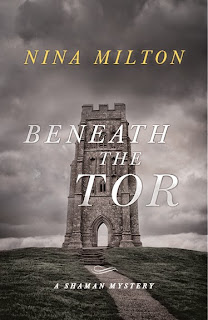 In Beneath the Tor – book three of the series – a sudden death becomes a catalyst…Alys was dancing as the stars reeled, dancing on Glastonbury Tor on Midsummer Eve. She danced as if the drumbeats were bursting out of her. As if her feet were charmed to never rest.
In Beneath the Tor – book three of the series – a sudden death becomes a catalyst…Alys was dancing as the stars reeled, dancing on Glastonbury Tor on Midsummer Eve. She danced as if the drumbeats were bursting out of her. As if her feet were charmed to never rest.I saw her dance.
She fell to the ground without a stumble or a cry.
Right now, I'm writing book four, and this time we definitely have status quo causing the murder we witness see right at the start. At the same time Sabbie is helping her old friend Debs through a terrible time, which will involve finding a missing girl…and the men who are holding her prisoner…
 |
| Even I get terrified when I read my books |
“Sabbie Dare is the most compelling protagonist I’ve met this year . . . Milton’s tale is riveting.”…Library Journal starred review
 1
1
MOBY-DICK; or THE WHALE by Herman Melville
 |
| Herman Melville |
Most of the information between the pages is now anachronistic and almost forgotten, but I was fascinated by how whale blubber was rendered down on board into barrels of oil – how the first steak from a kill would be eaten ceremoniously. And yet, counterpointing all the minutiae and trivia, the ways of Moby Dick remain unknown. Melville (and Ishmael) are sure upon that; the white whale is like God in his Heaven, which makes Ahab a fool for trying to find and outdo him. The result, of course, is futile…and fatal.
Apple Tree Yard by Louise Doughty; soon coming to BBC TV
|
Louse Doughty in London. Photo: Andrew Crowley, The Telegraph I love it when a favourite read of mine is set to become a film or TV drama because I can bore everyone to pieces by droning on about how the book is so much better than the film, while secretly enjoying the story all over again.
|
I recently reviewed Susanna Clarke's book, Jonathan Strange and Mr Norell in this way, and now can’t wait to watch
|
Faber & Faber UK |
Apple Tree Yard,
the steamy psychological thriller by Louise Doughty, on BBC telly. I call this a thriller, but Doughty herself says…the weird thing is, I don’t think I’m writing thrillers, but quite a lot of other people seem to. I thought Apple Tree Yard was a feminist indictment of criminal justice…
|
Emily Watson, one of my favourite actors, will play Yvonne Carmichael, a middle-aged woman who falls heavily in lust…I am both relishing and daunted by the prospect of taking on this role…she’s already been quoted as saying…it’s grown up, steamy and of queasy moral complexity… |
|
|
|
Watson in Gosford Park Photo by rottentomatoes.com |
If you’re not already familiar with Watson’s work, try her early films. I first saw her as Maggie, in the TV adaptation of Mill on the Floss, but then caught Hilary and Jackie, in which she plays the cellist Jacqueline du Pre. She was brilliant in the star-studded film Gosford Park, and most recently, she was wonderful in The Theory of Everything, the film about Stephen Hawkin.
The BBC describes Apple Tree Yard as…a provocative, audacious thriller that puts women’s lives at the heart of a gripping, insightful story about the values we live by and the choices we make…But what I recall most vividly about the story is how quickly I was hooked. Doughty shows Yvonne Carmichael's well-ordered life plummeting into the ground. At the outset, Yvonne is a happily-married, eminent geneticist who, after giving evidence to a Parliamentary Select Committee, meets Mark (who’ll be played by Ben Chaplin) on her way out of the House of Commons. Her fall to earth begins as they indulge in raunchy sex in a crypt chapel.
Yvonne thinks she can keep her marriage and her red-hot affair in separate compartments, but, from the start of the book, we know she is on a downward spiral because we’ve already caught a glimpse of her future – and it’s not good. Or, as Hilary Mantel says…there can’t be a woman alive who hasn’t once realised, in a moment of panic, that she’s in the wrong place at the wrong time with the wrong man…A compelling and bravely written book…
Something I always relish in a novel is the use of place to bring the right atmosphere to the writing. This almost always involves good descriptive skills…the Chapel of St Mary Undercroft in the Palace of Westminster beneath the drowned saints and the roasted saints and saints in every state of torture…
I read the book after it was shortlisted for the Crime Writers Association Steel Dagger (for best thriller), in 2014. Like most readers, I was gripped, not just by the heat of the read, but also by the varied styles Doughty uses. Yvonne has sex with Mark in seedy locations; a broom cupboard, a disabled toilet, the secretive doorways and back alleys of London. In between these scenes, written in the difficult and arresting 2nd person point of view…I don’t know it yet, but the man is you…Yvonne writes long letters to Mark which deepen our emotional connection to her, which she hides on her computer in a file marked VATquery3. Every so often, we return to the trial. The two of them are in the dock at the high court. All that illicit passion, betrayal and deceit has led to murder. A perfect story for a four-part television drama, in other words.
Before reading the book, I knew Doughty had already written, between her other novels, a book called A Novel in a Year, originally a series of articles in the Telegraph. Writing a book in a year isn’t necessarily a good thing. The writer may end up with something less than perfect, too hurried. But on the other hand, knowing you are going to write every day for 52 weeks
(a chapter a week, perhaps, or a first draft in 6th months, leaving half the time for research and revision), concentrates a writer’s mind wonderfully. I read A Novel in a Year in 2015 because I was about to do just that. The third of my Shaman Mystery Series Beneath the Tor was delivered to the publishers precisely one year after I’d agree the contract date, and I used the Nanowrimo method, to kick-start the process – http://kitchentablewriters.blogspot.co.uk/2014/02/writing-that-very-first-draft.html
Louise Doughty has already managed that…My first, Crazy Paving…took me 18 months. By the time it came to writing my second, I was theatre critic for a Sunday newspaper, which meant I had all day to write before going to the theatre in the evenings: as day-jobs go, it was a corker. Dance With Me was written in seven months. Honey-Dew… about a girl who murders her parents…was written in eight months while I was sick with exhaustion…
Doughty’s most recent book, Black Water (Faber & Faber UK, Farrar Straus & Giroux/Sarah Crichton Books US) was published a full 3 years after its predecessor, Apple Tree Yard, but it is very different, with a new direction again. She’d gone to Bali, where the book is set, for a literary festive, and came back with the seeds of an idea.
I was lying awake…and a really strong image came to me of a man lying awake at night in a hut in Indonesia, mortally afraid. Why is he so afraid? In the opening pages, he decides that men with machetes are going to come and kill him. But I didn’t actually know who he was, I didn’t know how old he was, I didn’t know why he was there. But what I did know about him was that what he was afraid of wasn’t what was going to happen; he was afraid of something that he himself had done…Of course, he’s a metaphor for Indonesia itself. Because a military dictator came to power in 1965, there was never any truth and reconciliation, there was never any coming to terms with this massacre.
Likened to a John LeCarre, and described by The Bookseller as…a meditation on guilt and responsibility…I can’t wait to get my teeth into a new Doughty story, while I’m waiting for Apple Tree Yard to appear on the small screen.
website http://www.louisedoughty.com
 1
1
A day at the Hay Festival
|
Marlon James, 2015 Booker prize-winner, with OCA alumni, Pat |
A Day at the Hay with the OCA
A day in the sun at Hay…it’s one of the selling points of the Hay Festival – photos on the website are focused on people under sun umbrellas reading their latest purchase and drinking cool lager. This is a risky ploy for a Welsh summer event, but it paid off for the Open College of the Arts posse that arrived at the festival grounds on bank holiday Saturday. We’d come for the culture, of course we had. We’d come for the literature, naturally, for the heightened conversation we’d enjoy with each other after sharing events. But the fact the sun was out certainly helped. We'd come to see the stars of the literary world, and they turned out to be really nice people as well as great writers...
|
A Nobel Laureate, a Man-Booker winner, the Samual Johnson Prize winner... no, not us in the selfie, the great writers we'd come to enjoy |
to read the rest of this blogpost, follow the link to weareOCA
 3
3
THE NAXALITES
Talk about buses, coming along in pairs.
Two books, published recently, both examined the Maoist uprising in India. Now, I didn’t even know that there had been a Maoist uprising in India, so two novels in close succession felt like more than coincidence. But it's probably no more than a good example of Jung's collective consciousness at work.
In both books, a young man is drawn into a radical far-left movement called Naxalism, its name derived from Naxalbari, a tiny village to the north of Calcutta where impoverished peasants rose up against the police and landlords in 1967, sparking off dreams of a nationwide insurgency that would replicate Mao’s earlier revolution in China.
I read Jhumpa Lahiri’s Lowland first, and this was my introduction the the Naxalites, a movement I’d never heard of before. I love learning new things from the fiction I read, however, at the end of the book, I still didn’t know anything about the uprising. That story is skirted and what is examined instead is disappearance, the not knowing.
Subhash’s younger brother, Udayan, has gone without trace, and he’s missed by all the people who care for very much for him in a multitude of different ways Lahiri explores these lives – lives lived with a blankness where a person should be. What Lahari is saying, it seems to me, is that disappearance is more poignant than death, for there is no closure when someone vanishes off the face of the earth. Udayan's family are trapped in the unkowning. How differently would have been their lives if that disappearance hadn’t happened? How different are their lives because of that mysterious gap appearing in the centre of the family.
As I was reading Lowlands, I fell in love, once again, with Lahari’s erratic, dancing prose and the power of her characters, who feel and believe and with such passion and depth. But her short stories are more lucid than this longer book. The writer is far better at getting under the skin of characters
like this, exploring their dreams, fears, failures and secrets, than she is describing settings or actions. Rather than demonstrating any overarching narrative drive, Lahari’s Indian family seem to live in the clouds, if not in the Cloud. But at the end of the book, I could truly say I'd loved it, because the ending is exqusiite. It both explains the beginning and takes us in a circle back to it. It’s because of this one little device, which I had to wait 432 pages for, that Lowlands stays with me,
In direct contrast, The Lives of Others, by Neel Mukherjee does not try to
uprising. We learn how punishing was the regime the idealistic students set for themselves, in their attempts to emulate Chinese Communism, and we also see in graphic detail the way the police and state dealt with their beliefs.
The structure Muckherjee has chosen takes us alternately from the Ghosh Family (and their long-standing business empire) and their teenage son, Supratik. The family - or at least Supratik's mother - is struggling, as in Lowland, to come to terms with the disappearance. Their lives, in contrast to the starving peasants Supratik is now starving alongside, are rich and charmed, to the point they simply cannot imagine any other life. As with Lowlands, we watch several generations, this time mostly in flashback back from the starting point of 1967, to learn how much the family members truly hate each other.
While Lowlands had a problem with getting to grips with setting, this book seems to not bother with properly introducing characters. Constantly I got lost and frequently I was grateful for both the glossary and the Ghosh family tree, printed at the front of the book.
I found the chapters focused on Supratik grueling but easy to read. It was the Ghosh chapter I found troublesome. I seemed to constantly be waiting for characters and their situations to be introduced and explained, while trying to figure out what was happening and what had happened to this unpleasant family. I almost gave up several times, as I wondered where this book was going. But when the writer gets to grips with a scene, he's wonderfully colourful and imaginative.
The Lives of Others seemed to be telling and showing me far less than I thought I'd need to understand the story, yet, when when I’d finished it, and pondered upon it, I realized that somehow I’d gained a complete picture and could see the romance and direction of its narrative perfectly.
If you like to discover new information while reading fiction, or love books that tackle large issues, you'd probably enjoy either of these. Lowland was short-listed last year: The Lives of Others won the prize the year after. Why not read both and decide for yourself if the Booker judges made the right choices.
 1
1
Beneath the Tor by Nina Milton
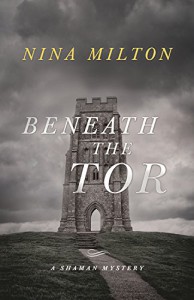
Thank you, Publisher's Weekly, for the great review of my new book!
Nina Milton. Midnight Ink (midnightinkbooks.com), $14.99 trade paper (432p) ISBN 978-0-7387-4382-0
At the start of British author Milton’s unsettling third Shaman mystery (after 2014’s Unraveled Visions), a group of 10 people, all “keen to explore shamanism,” climb to the top of Glastonbury Tor to celebrate Midsummer Eve. When Alys Hollingberry, who has been dancing nonstop, suddenly collapses, Sabbie Dare phones emergency services. Another participant says it’s too late (“I saw her spirit go”). On the day of the inquest, Alys’s grieving husband, Brice, receives a strange email (“The Tor needs no sacrifice. The utter waste of blessed life signals doomsday”). It’s signed Morgan le Fay. Since Brice doesn’t want the police involved, he asks Sabbie’s help in identifying Morgan le Fay and figuring out this person’s connection to Alys. Meanwhile, a priest alleges that Alys took drugs during the celebration on the tor that may have led to her death.
Milton puts an intriguing New Age spin on the traditional English mystery.
 2
2
The Chimes by Anna Smaill
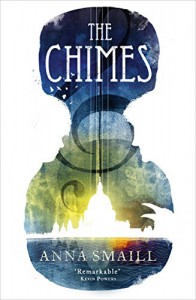
The Chimes by Anna Smaill
 |
| Anna Smaill Photo Credit - Natalie Graham |
 |
| The Thames from Oxford to London |
 2
2
Walking the Rainbow Path: an article on shamanism by Nina Milton
Walking the Rainbow Path
Can the Shaman Mysteries Passt the Bechdel Test?
Can I pass the Bechdel Test?
 |
| https://en.wikipedia.org/wiki/Bechdel_test |
 |
| Helen Hunt as Carol |
 |
 |
| In the Moors |
 |
| Unraveled Visions |
 |
| Beneath the Tor |
 2
2
Beneath the Tor: What a Grand Launch; it rocked and BuZZed
WHAT A GRAND LAUNCH:
IT ROCKED AND BUZZED!
BENEATH THE TOR by NINA MILTON
|
Some people came by broomstick… |
Saturday 27th February, I launched the third in my Shaman Mystery Series, Beneath the Tor, at The Avalon Room in Glastonbury.
|
Others flew in from Ireland, |
I’m please to tell you that it was a blast; everyone had a great time, there was standing room only, and as one attendee said on facebook…Ronald Hutton – and chocolates!
Here are some memories of the event:
Sam: Was great fun. Really enjoyed it. Congratulations. Downloaded the book to my kindle last night. Now just waiting for some peace and quiet to start reading... It may be a while but can't wait!!
Judy: A lovely mix of a fascinating talk, brilliant snatches of reading and a great end with that great singer who entertained us as you were signing your books
John: Well done Nina
Lu: Lovely day out in Glastonbury at Nina Milton's fab book launch.
Claire: Enjoyed seeing you and Jim and the lecture and reading were great.
Sarah: Avalon calling. Just returned from a weekend at magical, mystical Glastonbury. Plugging myself into the spiritual mains, so to speak. A bit of a whirlwind weekend actually, it was great to be at the fab Nina Milton’s book launch on the Saturday afternoon, an excellent talk by Prof Ronald Hutton with acoustic guitar and song by Arthur 'ZZ Birmingham' Billington..
I managed to have an hour of contemplative practice in Chalice Well gardens which reminded me of times gone by ... both joyful and not so joyful. Mixed feelings really. The whole experience served to remind me that wherever we are, the Land is sacred. We do not need to travel to another place to appreciate it. Honour Mother Earth and experience Her delights everywhere!
Steve: Hi we had a great time
Charlotte: Thanks for making [my children] so welcome - I only hope they left some buffet for everyone else and didn't completely decimate the Ferrero Rochet...Anyway I've already read the book and I blame you entirely for my lack of sleep due to not being able to put it down.
David and Cathryn: had a wonderful time, and I thought the book launch went exceptionally well. I really enjoyed being back in Glastonbury, and I have started 'Beneath the Tor'
Aravis: That was such a lovely week-end, everything went perfectly, as far as I could see. I hope you were happy with it. Thank you very much for inviting me!! I'm enjoying Beneath the Tor so much I would like more of my friends to get to read it
Vicky and Bob: had a most memorable Glastonbury Experience! Thank you too.
Sue: Arthur ZZ Birmingham rocked the crowd! I thought the roof was gonna lift right off.
If you were there, I hope you are now enjoying Beneath the Tor, or other books from the Shaman Mystery Series. Please remember to write up your review for Amazon, Booklikes or Goodreads.com. And why not ask your local library to stock them? Finally, having finished with the book, why not pass it on or lend it to a friend?
But if you weren’t there, you can indulge now in some of what went on during the afternoon.
Nina explained how she’d wanted to write ever since her reception class teacher told the class to write a story and she realized that the lovely books her daddy had been reading her hadn’t just arrived from ‘book heaven’ but were actually written by people!
Ronald Hutton on Shamanism…
|
Witty, erudite and expansive, |
|
Professor Ronald Hutton talks about shamanism |
Ronald Hutton is professor of history at Bristol University and a world authority on paganism. He gave a talk on the history of shamanism, concentrating on how it arrived in the West and was taken up and made obtainable by the great exponents in this country and the US especially. He then very cleverly (well, he is clever!) explained how my books tapped this seam. Readers nowadays like two particular genres of novel; crime fiction and fantastic fiction. By entering Sabbie Dare’s two worlds…as a 30 year old woman faced with dilemmas, worries and, sometimes, danger – and her journeys into the spirit world as a shaman…I have successfully blended the two. (thank you, Ronald...)
Nina's Readings:
From In the Moors…
|
Nina Milton reads from her series |
“It was awful,” said Cliff. I’d given him a glass of water and he was holding on to it as if it was a healing elixir. The pulps of his fingertips were crushed around it, until the surface of the water trembled and slopped onto his cords jeans.
“Perhaps it will help to describe what happened to you.”
Cliff downed the rest of the water and spent time examining the tumbler, turning it round and round and gazing into it as if it were a crystal ball. His hands were bony at the knuckles, the fingers long and pale… to read more from the book, click here
From Unraveled Visions…
 The retrieval was unceremonious and without dignity. The woman’s body was winched from Dunball Wharf at 17.13, dripping with sluice-slime. The hip bones shone white against the sun and there were fish swimming in her belly… To read more from this book click here
The retrieval was unceremonious and without dignity. The woman’s body was winched from Dunball Wharf at 17.13, dripping with sluice-slime. The hip bones shone white against the sun and there were fish swimming in her belly… To read more from this book click here
From Beneath the Tor…
“A chivalric slaying,” said Morgan. “It was promised.”
The acolyte had brought them here. It was his plan to find Sabbie Dare. He didn’t expect to witness such distress.
Such magic.
For there he is. Ready for the taking. The Black Knight.
The man in black hurtles down the stairwell. He goes straight past them. A door bangs below.
He can do this. He wants it. First time. A line of cold steel straightens his back. His hands are steady; rock-hard fists…to read more from the book click here
Arthur ‘ZZ Birmingham’
|
Arthur ZZ Birmingham creating a storm |
This is where the party really began! Arthur, blues guitarist extraordinaire, knocked the crowd’s socks off with his wonderful music. Everyone had their foot tapping as he played and sang. Thank you so much Arthur for making the afternoon complete and filled with a great buZZing atmosphere!
|
Thank you, and goodbye... |
 1
1







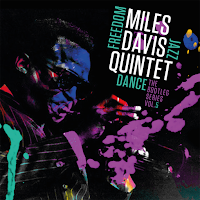



 1
1






























